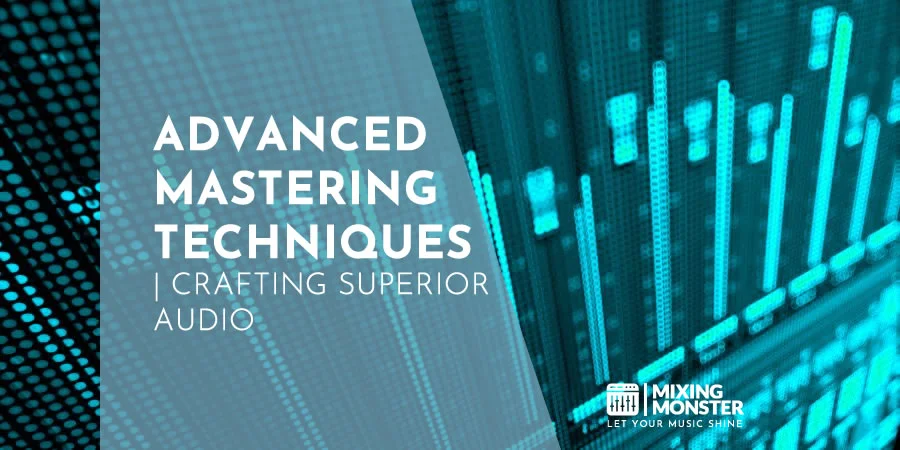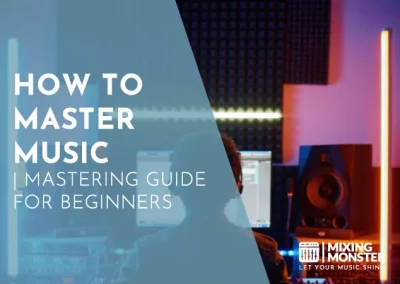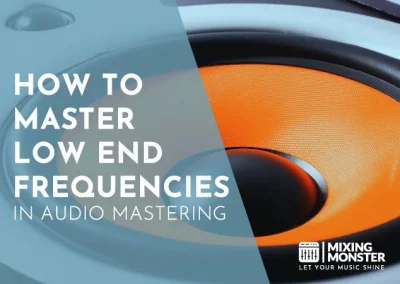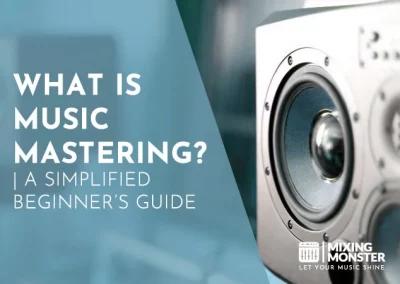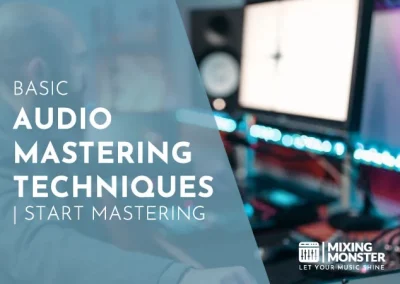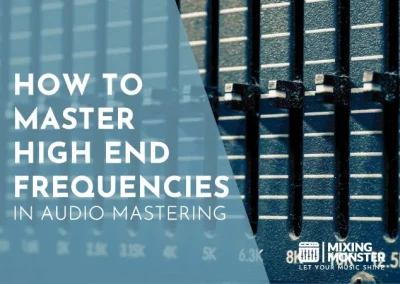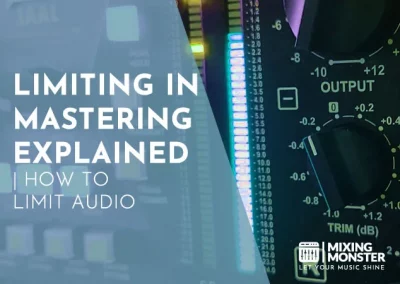Disclosure: Some of the links below are affiliate links, meaning that at no additional cost to you, we will receive a commission if you click through and make a purchase. Read our full affiliate disclosure here.
Mastering is the final step in music production, where a mastered track is polished to achieve the best possible sound. Advanced mastering builds on basic techniques to elevate the sonic quality further, demanding higher precision and a deeper understanding of audio processing.
Advanced mastering is a sophisticated process that fine-tunes a mix to ensure clarity, depth, and balance across various playback systems. A mastering engineer applies advanced techniques, such as equalization, compression, stereo enhancement, and loudness optimization, to achieve a coherent sound. Employing progressive tools and software, the engineer makes subtle adjustments that can significantly impact the track’s final presentation.
By exploring advanced mastering, you’re taking a vital step toward producing music that stands up to professional scrutiny. You will learn the technical aspects and nuances that can significantly impact your final product. Expect to uncover the secrets behind genre-specific approaches to mastering, techniques for achieving impeccable stereo imaging, and practices that prepare your music for any platform it graces.
KEY TAKEAWAYS:
- Mastering is the final touch in music production that ensures consistency and quality.
- Advanced mastering involves precise techniques to enhance clarity and sonic integrity.
- Learning these skills is imperative for a professional-sounding final product.
Table Of Contents
1. Introduction To Advanced Mastering Techniques
2. The Art Of Surgical Audio Mastering
3. Genre-Specific Audio Mastering Approaches
4. Stereo Imaging And Spatial Enhancements In Mastering
5. Loudness Standards And Metering In Mastering
6. Pre-Mastering Best Practices
7. Mastering For Different File Formats
8. Advanced Mastering Tools And Mastering Softw
9. Concluding Thoughts On Mastering Excellence
10. FAQ

1. Introduction To Advanced Mastering Techniques
As the music production landscape evolves, so must the art of mastering. In this section, you’ll gain insights into the sophisticated practices that define contemporary mastering, with a focus on the intricate tools and techniques that contribute to achieving professional audio quality.
Advanced Mastering In The Digital Age
Advanced mastering techniques hinge on precision and creativity in today’s digital domain. Tools such as high-resolution equalizers, multiband compressors, and limiters are pivotal in sculpting the final sound.
You’ll find that understanding the details and application of these tools is crucial. Engaging with ‘master along’ videos and hands-on learning experiences, where you work with practice files from diverse songs, can dramatically improve your familiarity with top-tier sound production.
Setting The Stage For Professional Audio Quality
Professional audio quality is not attained by chance; it requires judicious control over gain and the audio spectrum. Your objective is to create a coherent sonic experience across all playback systems.
To set the stage, you’ll need to be versed in using advanced mastering tools to finely balance the dynamics and equalization of each track, ensuring mastering excellence without sacrificing the artist’s original intent.
Understanding The Scope Of Advanced Mastering
Advanced mastering is much more than the final polish of a mix. It’s about making informed decisions that enhance the entirety of a project. Each song presents unique challenges that necessitate a customized approach.
The path to mastering efficiency lies in practicing with various tracks and refining your methodology to deliver pristine, industry-standard results consistently.
2. The Art Of Surgical Audio Mastering
Mastering audio balances science and art, demanding precision and creativity. In this section, you’ll discover how surgical mastering techniques allow you to manipulate sound with excellent specificity, from fine-tuning dynamics to enhancing harmonics for a polished final product.
Mastering Dynamic Range Control And Compression Techniques
Understanding the dynamic range and the application of compression is essential in mastering. You aim to achieve balance, ensuring no elements are too dominant or lost.
Techniques such as parallel compression can add punch without squashing the life out of a track. Using a compressor, focus on ratio, threshold, and release settings to maintain the natural characteristics of the original recording.
Keep your touch light to avoid over-compression, making a flat and lifeless sound.
EQ Mastering Strategies For Precision And Clarity
EQ settings have a profound impact on the precision and clarity of a master. Employ dynamic EQ as a scalpel to cut or boost frequencies only when necessary, maintaining a track’s natural ebb and flow. A good strategy is to:
- Identify and cut problematic frequencies first to clean up the mix.
- Use narrow Q values for surgical adjustments and broader Qs for general tone shaping.
When boosting frequencies, remember that less is often more. Subtle boosts can maintain clarity while avoiding phase issues.
Harmonic Enhancement And Saturation Nuances In Mastering
Saturation can add warmth and character, imbuing a track with subtle harmonics that enhance the listening experience. However, know when and how much to apply:
- Use a tube or tape saturation to enrich a flat mix with harmonics.
- Focus on the mid-range to add presence or on the low-end to increase perceived loudness.
Understanding dynamics processing is crucial for maintaining the integrity of the track while applying saturation. It should enhance, not mask, the subtleties in your audio.
3. Genre-Specific Audio Mastering Approaches
Mastering is the final touch that brings your mix to life, making it essential to tailor mastering techniques to the genre of music you’re working with. This section explores the unique strategies for different genres, ensuring your music resonates with clarity and precision.
Tailoring Techniques For Mastering Electronic Music
Electronic music thrives on a clean, dynamic range and a punching bass that does not overshadow other frequencies. When mastering electronic tracks, it’s crucial to strike a balance where the kick and bass synthesize seamlessly, allowing the melody and rhythm elements to convey the intended energy and emotion.
- Ensure the low end is tight yet powerful — critical in genres like house, techno, and dubstep.
- Utilize stereo widening judiciously to enhance the spatial experience without sacrificing the track’s focus.
The Nuances Of Mastering Rock And Metal
The aggressive and raw power of rock and metal requires mastering that maintains the guitars’ impact and the drums’ punch without losing clarity.
- Preserve the dynamic range to retain the expression and energy of the performance, avoiding over-compression.
- Carefully control mid-range frequencies to avoid muddiness, primarily where guitars and vocals compete for space.
Acoustic And Classical Music Mastering
In acoustic and classical genres, nuance and detail are paramount. The mastering approach here should respect the natural dynamics and tonality of the instruments.
- Aim for transparency, where the mastering complements rather than redefines the quality of your music.
- Ensure that the stereo image preserves the experience of a live performance, showcasing the intricacy and interplay between the instruments.
4. Stereo Imaging And Spatial Enhancements In Mastering
Mastering stereo imaging and spatial enhancements is crucial to achieving a sonically pleasing and spacious mix. Your mastering process should focus on creating an expansive stereo field without compromising the balance and integrity of the mix.
Advanced Mid/Side Processing In Mastering
Mid/Side (M/S) processing allows you to manipulate the middle (mono) content and the side (stereo) content of your track separately. When you master advanced M/S techniques, you gain precise control over the stereo image, tailoring both the center elements of your mix, like vocals and bass, and the side elements, such as cymbals and atmospheric pads.
Employ M/S equalization judiciously to enhance clarity and separation, while M/S compression can help maintain dynamic balance across the stereo field.
Depth And Width Manipulation Strategies In Mastering
Achieving width and depth in your tracks requires a strategy considering the spectral content and the desired spatial perception. To introduce depth, subtle reverb or delay can position elements further back in the mix; use these sparingly to prevent muddiness.
For width, explore stereo widening tools but remain cautious to avoid phase issues; always check your mix in mono to ensure compatibility. You aim to create an expansive stereo image that stays true to the original mix’s balance and character.
Achieving Balance And Focus In The Stereo Field
Your ultimate aim in mastering is to attain a well-defined stereo field where every element has its distinct place, thus ensuring a focused and balanced mix.
To do this, you must assess the pan positions and stereo image—and employ automation to make subtle adjustments if needed, promoting a transparent and cohesive mix.
Always be mindful of the width and depth cues already present, and enhance these using stereo imaging tools to complement, not overshadow the original mix characteristics.

5. Loudness Standards And Metering In Mastering
Mastering modern playback environments requires an understanding of loudness standards and precise metering. This section unpacks key concepts like LUFS and dynamic range, discusses mastering for streaming platforms, and examines the impact of loudness decisions.
Understanding LUFS And Dynamic Range
Loudness Unit Full Scale (LUFS) has become the standard for measuring perceived loudness, which is crucial for balancing the dynamics of your master. Dynamic range—the difference between the loudest and softest parts—combined with LUFS informs the level of clarity and punch your track will have. It’s essential for ensuring your music feels both powerful and dynamic.
Targeting Streaming Platforms With Precision Mastering
Different streaming platforms have specific loudness targets, and hitting them right combines art and science. Knowing the gain levels appropriate for platforms like Spotify or Apple Music means your track will sound its best without unnecessary limiting or distortion that can occur with over-compression.
The Impact Of Loudness On Mastering Decisions
Your loudness choices directly influence the listener’s experience. Heavy limiting may increase loudness and reduce dynamic range, leading to fatigue. The correct gain for your master is a delicate balance—too high, and you’ll lose dynamics; too low, and your track may lack impact. Use precise metering to guide your choices for a master that serves the music best.
6. Pre-Mastering Best Practices
Correct pre-mastering practices ensure that your mix translates well in the mastering phase, retaining all the nuances of your work. Let’s break down the essential steps to ensure your tracks are perfectly primed for the final polish.
Preparing Mixes For The Mastering Phase
Before handing off your mixes for mastering, confirm every track is meticulously balanced, and the mixdown is optimized. This involves giving a critical listen for mixing feedback to guarantee that the EQ and compression serve the track effectively without muddling the mix. Aim to preserve the integrity of transients and ensure that multiple tracks blend harmoniously.
Key Steps:
- Double-check the balance between tracks; each element should be heard clearly.
- Listen for any conflicting frequencies and adjust EQ accordingly.
- Apply dynamic range compression judiciously to maintain natural-sounding transients.
Headroom Considerations And Gain Staging
Proper gain staging is critical; it governs the dynamic range and headroom—the space between your track’s peak levels and the clipping point. For mastering, aim for a peak level of around -6dB to allow the mastering engineer enough room to work.
Gain Staging Tips:
- Keep your peak levels consistent across tracks.
- Use meters to monitor levels accurately, avoiding clipping.
- Adjust individual track levels before applying bus compression to maintain headroom.
Cleanup And Restoration Before Mastering
The pre-mastering stage is also your final chance for cleanup. Address noises, clicks, and any unwanted artifacts that can detract from the sonic clarity. In some cases, audio restoration tools can be used to repair transient smearing or subtle glitches.
Cleanup Checklist:
- Employ high-pass filters to eliminate low-end rumble on non-bass tracks.
- Utilize noise reduction tools for consistent noise like hum or hiss.
- Clip gains individual problem sections instead of broadly applying compression or EQ.
7. Mastering For Different File Formats
When mastering audio, you must consider the end format’s impact on your sound. Each file format offers varying degrees of fidelity and may require different mastering techniques to preserve your track’s optimal quality.
Lossless Versus Lossy Audio Considerations
Lossless audio formats like FLAC or WAV retain the full quality of the original recording. Your mastering should aim for a top-tier sound with a full spectrum presence, ensuring that no part of the audio’s dynamic range is compromised.
In contrast, lossy audio formats like MP3 or AAC require meticulous attention to prevent clipping and the loss of certain frequencies. Here are specifics to consider:
- Be wary of overly aggressive limiting. This may cause clipping, especially when converted to lossy formats.
- Tastefully apply compression. Lossy formats can accentuate artifacts, so aim for restraint.
High-Resolution Audio And Its Implications
Mastering high-resolution audio involves working with formats higher than the standard CD quality (44.1kHz/16-bit). When dealing with 24-bit/96k or higher, you have a broader spectrum to play with, which translates to more detail in the audio.
- Ensure your mastering chain can handle these higher resolutions without introducing unnecessary format conversion artifacts.
- Take advantage of the increased headroom. In this rarified quality, Aria can breathe, exemplifying clarity and depth.
Format-Specific Mastering For Vinyl, CD, And Streaming
Different physical and digital formats have unique characteristics catered to by format-specific mastering:
- Vinyl
- RIAA equalization is crucial; adapt your low and high-end to accommodate the vinyl’s physical limitations.
- Mono bass ensures that low frequencies don’t cause needle skipping.
- CD
- Red Book Standards must be adhered to (44.1kHz/16-bit).
- Aim for a clear representation across all playback systems.
- Streaming
- Loudness normalization practices of streaming services mean you must keep integrated loudness levels in mind.
- Consider the platform-specific nuances—some, like Apple Digital Masters, accept high-resolution files.
By considering these elements, your mastering process will align with the demands of various playback formats, maintaining the integrity and quality of your audio across mediums.
8. Advanced Mastering Tools And Mastering Software
You can access sophisticated tools designed to refine and enhance audio fidelity in advanced mastering. Your workflow benefits from software precision, seamless automation, and even the integration of AI innovations that push the boundaries of sound.
Exploring Cutting-Edge Mastering Plugins
Your quest for pristine audio can lead you to groundbreaking plugins. Among these, iZotope’s Ozone stands prominent, offering comprehensive mastering tools with features like multiband compression, harmonic excitation, and a suite of advanced EQs. Over-sampling within some of these plugins ensures higher fidelity by reducing digital distortion.
The Role Of Analog Gear In A Digital World
Despite the digital revolution, analog gear is crucial to mastering due to its unique warmth and character. Incorporating analog into your digital signal path can add the sought-after harmonics that provide richness and depth, a quality often missing in digital-only workflows.
AI-Assisted Mastering And Future Innovations
Looking to the future, AI-assisted mastering tools like LANDR are transforming how you approach mastering. These advanced systems analyze your music and apply precise signal processing, greatly simplifying the mastering process while maintaining high standards. By introducing AI into your arsenal, you’re not replacing your creative instincts but augmenting them with intelligent automation.
9. Concluding Thoughts On Mastering Excellence
In mastering audio, your ultimate goal is to achieve a level of excellence that allows your music to stand out. This requires dedication to continual improvement, a deep understanding of your craft, and a forward-thinking mindset.
Continual Learning And Adaptation In Audio Mastering
Mastering excellence is not a fixed target but an evolving standard that demands your ongoing commitment to learning and adaptation. Whether you’re adjusting to new audio formats or incorporating the latest mastering software, the ability to embrace change is crucial. A successful mastering engineer possesses advanced critical listening skills and readily adapts to shifts in the industry.
Consistently enhancing your capabilities through real-time instruction and feedback is how you progress through a transformational journey in audio mastering. This journey empowers you to handle various skill levels, ensuring that every project you undertake benefits from a well-rounded mastering experience.
The Ethos Of A Professional Mastering Engineer
Being a professional mastering engineer involves more than technical prowess; it involves an immersive approach that encapsulates your work ethic, attitude, and the acute attention to detail required to consistently and effectively apply your skills.
Aligning yourself with the seasoned precision of experienced producers, you’ll find that your contributions can significantly elevate your music and career.
Your role extends beyond adjusting frequencies; it’s about shaping the emotion and dynamic of a track. Every adjustment you make ensures that the end product faithfully represents the original intent of the music.
Looking Ahead: The Future Of Audio Mastering
Reflecting on the changing landscape, it’s imperative to look ahead toward the future of mastering. As technology advances, your strategies and methodologies will need to evolve. A proactive attitude toward innovation will ensure you are equipped to meet new challenges and opportunities.
Your pursuit of mastering excellence promises to evolve with the industry continually, exploit cutting-edge tools, and cultivate an environment where your music meets today’s high standards and sets new ones for tomorrow. Embrace this continuous journey confidently and anticipate the remarkable sonic landscapes ahead.
10. FAQ
1) What software do professionals recommend for high-quality audio mastering?
Professionals often recommend Waves plugins for their comprehensive suite of high-quality mastering tools. These are renowned for precision and control in audio mastering.
2) What techniques do experts employ to achieve advanced mastering in music production?
Experts use various techniques, including dynamic equalization, multiband compression, stereo enhancement, and judicious limiting, to preserve dynamic range while achieving loudness.
3) Which certification programs are considered the most reputable for mastering engineers?
Internationally recognized certification programs by organizations like the Audio Engineering Society (AES) and the Society of Professional Audio Recording Services (SPARS) are deemed reputable for mastering engineers.
4) How important is hiring a professional mastering engineer for your music project?
Hiring a professional mastering engineer is crucial to ensure your music translates well across various playback systems and to provide the final polish that meets industry standards.
5) What are the recommended peak levels to aim for during the mastering process?
The recommended peak levels during mastering generally hover around -1 dBFS to prevent inter-sample clipping and allow for clean playback on all devices.
6) How does one determine the optimal mastering level for a specific music genre?
The optimal mastering level for a genre is determined by analyzing genre-specific conventions and standards, listener expectations, and the dynamic content of the track to ensure clarity and impact.

